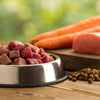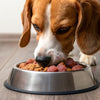How to Start a Raw Food Diet for My Dog: A Comprehensive Guide for Healthier Canine Eating Habits
- Houndsy
Table of Contents
- Introduction
- The Benefits of a Raw Food Diet for Dogs
- Understanding the Components of a Raw Food Diet
- Transitioning to a Raw Food Diet
- Meal Preparation Tips
- The Role of Houndsy in Your Dog's Feeding Experience
- Challenges and Considerations
- Conclusion
Introduction
Have you ever wondered if there’s a better way to nourish your canine companion? With countless options of processed dog foods lining the shelves, it's no surprise that many pet owners are exploring alternatives. Research indicates that a significant portion of pets suffer from dietary-related health issues, prompting a surge in interest regarding the raw food diet for dogs. Imagine your dog thriving, with a shiny coat, robust energy, and improved overall health—all stemming from a meal plan founded on whole, natural ingredients.
In this in-depth guide, we will explore how to start a raw food diet for your dog, delving into the benefits, the potential challenges, and a step-by-step approach to a successful transition. Whether you’re contemplating enhancing your dog’s diet or are looking for practical solutions to ensure the meals served are nutritious and visually appealing, this article will arm you with the knowledge you need to embark on this nourishing journey.
What You Will Learn
By the end of this post, readers can expect to gain a solid understanding of the advantages and considerations involved with a raw food diet for dogs. We will provide key insights into what constitutes a balanced raw diet, how to safely transition your dog to this new way of eating, and realistic tips for meal preparation. Furthermore, we will introduce our innovative product, the Houndsy Kibble Dispenser, designed to facilitate the overall feeding experience, making it easier for pet owners to provide a balanced diet.
The Benefits of a Raw Food Diet for Dogs
Before we dive into the nitty-gritty of crafting a raw food diet for your pooch, let's take a moment to examine the numerous benefits associated with feeding your dog raw food.
1. Enhanced Nutritional Value
One of the most significant advantages of a raw food diet is the high nutritional content. Unlike processed pet foods that often contain fillers, preservatives, and artificial flavors, raw diets prioritize whole ingredients. Fresh meats, bones, organs, fruits, and vegetables offer essential nutrients, amino acids, vitamins, and minerals. Research indicates that dogs do particularly well on diets rich in protein and healthy fats, which are abundant in raw food.
2. Improved Digestion
Dogs evolved as scavengers, and their digestive systems are designed for raw eating. Many pet owners report that raw-fed dogs experience fewer digestive issues compared to those fed dry kibble. The enzymes present in raw foods are believed to promote healthy gut microbiota, leading to smaller, firmer stools.
3. Healthier Skin and Coat
A balanced raw diet can significantly improve your dog’s skin and coat health. The oils and fats from raw animal proteins help promote a shiny coat, reducing itching and irritation often caused by commercial dog foods.
4. Increased Energy Levels
Raw diets are often touted for boosting dogs’ energy levels. The whole food components support better metabolism, enabling dogs to have sustained energy throughout the day.
5. Weight Management
When properly balanced, raw diets can aid in weight management. Unlike some processed dog foods that may be heavy in carbohydrates, resulting in weight gain, raw diets offer protein and healthy fat sources that can promote a leaner body condition.
Understanding the Components of a Raw Food Diet
To successfully start a raw food diet for your dog, it is vital to understand the essential components that make up a balanced meal. A typical raw food diet consists of:
1. Meat
The foundation of a raw diet is high-quality meat. Options include beef, chicken, lamb, rabbit, and fish. It’s crucial to prefer muscle meat that offers the necessary protein source.
2. Organs
Adding organ meats (like liver and kidney) is essential for providing key vitamins and minerals. Organ meats are nutrient-dense and should make up approximately 10% of your dog’s diet.
3. Bones
Raw, meaty bones are crucial for not only dental health but also for supplying calcium. The bones should be raw to avoid splintering during eating, which can be harmful.
4. Vegetables and Fruits
While dogs are primarily carnivorous, incorporating fruits and vegetables can offer additional fiber, antioxidants, and essential nutrients. Suitable options include carrots, broccoli, blueberries, and apples.
5. Supplements
Depending on your dog's specific dietary needs, you may want to consider supplements. Omega fatty acids, probiotics, and vitamins can help to ensure a well-rounded diet.
Transitioning to a Raw Food Diet
Making the switch to a raw food diet can be daunting, but a steady and methodical approach can make the transition smooth and comfortable for both you and your dog.
Step 1: Research
Before embarking on this journey, we encourage you to thoroughly research raw feeding practices. Engage with veterinary professionals or canine nutritionists to gain a nuanced understanding of your dog's specific needs.
Step 2: Start Slow
A sudden transition can lead to digestive upset. Start by gradually introducing raw food into your dog's diet:
-
Week 1-2: Begin by replacing 25% of your dog’s current food with raw food, and observe how they adapt.
-
Week 3-4: Gradually increase the raw portion to about 50%, if their digestive system adjusts well.
-
Week 5-6: Continue this process until your dog is fully transitioned to the raw diet, fully replacing their previous food.
Sample Transition Schedule:
| Days | Current Food % | Raw Food % |
|---|---|---|
| 1-2 | 75% | 25% |
| 3-4 | 50% | 50% |
| 5-6 | 25% | 75% |
| 7-8 | 0% | 100% |
Step 3: Monitor Health
As you navigate this transition, closely monitor your dog for any signs of digestive discomfort, allergic reactions, or health complications. Keep an eye on their energy levels, coat condition, and stool quality. Engaging a veterinarian for regular check-ups during this period is advisable.
Step 4: Balance Your Diet
Ensuring a balanced raw diet can seem tricky. Utilize canine raw feeding guidelines or consult with a certified dog nutritionist. Aim to derive 70%-80% of the diet from protein sources, while maintaining the bone-to-meat ratio and including organ meats.
Meal Preparation Tips
Preparing your dog’s raw meals at home involves several best practices to ensure safety, efficiency, and satisfaction:
1. Use Fresh Ingredients
It's essential to source quality, fresh ingredients from reliable sources. If possible, choose grass-fed, organic, and hormone-free options.
2. Proper Portioning
Invest in a food scale to accurately portion your dog’s meals based on their weight, age, and activity level. Typically, a raw diet should constitute 2-3% of your dog's body weight daily.
3. Food Storage and Handling
Introduce a system for safely storing raw ingredients. Always use separate cutting boards and utensils for raw dog food to avoid cross-contamination.
4. Consider Meal Variety
To avoid a monotonous diet, consider rotating different protein sources weekly or bi-weekly (e.g., switch from chicken to beef). This variety not only keeps mealtime interesting but also ensures that your dog gets a broad spectrum of nutrients.
The Role of Houndsy in Your Dog's Feeding Experience
As we embrace the journey of raw feeding, it is paramount to weave in practicality and design excellence into our daily practices. That’s where our flagship product, the Houndsy Kibble Dispenser, comes into play.
Designed not just for kibble but adaptable for portioning raw meals, the Houndsy Dispenser promotes healthy feeding habits while ensuring convenience:
-
Perfect Portion Control: Effortlessly dispense the right amount without mess or fuss.
-
Clean and Convenient: Its ergonomic design means no bending or straining while serving meals—just a simple crank at standing height.
-
Stylish Interior Decor: Aligns with modern home aesthetics while seamlessly fitting into your kitchen or dining space.
For those looking to elevate their dog's feeding experience further, check out our Houndsy Kibble Dispenser here.
Challenges and Considerations
While raw feeding carries numerous benefits, some challenges may arise.
1. Bacterial Risks
Raw meat can harbor harmful bacteria. Practicing strict hygiene when handling raw food for your pet is critical to minimize health risks for both pets and humans.
2. Nutritional Balance
Balancing your dog’s raw diet to ensure it meets all nutritional needs can be complex. Consider seeking assistance from a veterinary nutritionist to create a tailored meal plan.
3. Cost and Preparation Time
Feeding raw can be more time-consuming and more expensive than feeding commercial kibble; however, the benefits often outweigh the costs. Strategically planning meals can help mitigate expenses and save time.
Conclusion
Transitioning your dog to a raw food diet is a rewarding journey that can significantly enhance their well-being. By understanding the core components of a balanced raw diet, gradually transitioning your pet, and maintaining a focus on safe and hygienic meal preparation, we can create a nourishing environment that supports their health and vitality.
Remember to embrace the process—like us at Houndsy, aiming for consistency and elegance in each feeding ritual. Share your experiences transitioning your dog to a raw food diet, and don’t forget to explore the Houndsy Kibble Dispenser for a chic and functional feeding solution!
FAQ
1. Is a raw food diet safe for all dogs?
While many dogs thrive on a raw diet, each dog’s health condition should be considered. Always consult your veterinarian before initiating dietary changes.
2. What are the main concerns about raw diets?
Concerns often include nutritional balance, safety risks related to bacteria, and the preparation time involved. It's critical to manage these factors as you embark on raw feeding.
3. Can I mix raw food with kibble?
While mixing raw food and kibble is possible for some dogs, it’s generally advisable to feed them separately to prevent digestive issues.
4. How can I tell if my dog is adapting well to a raw diet?
Look for improvements in coat health, energy levels, and stool quality. Occasional adjustments may be necessary as you tailor their raw food intake.
At the end of the day, you know your dog best! Let us make this feeding journey flourish, together.












